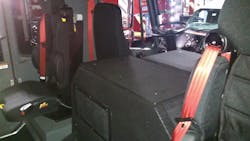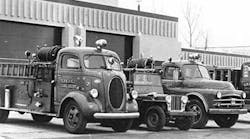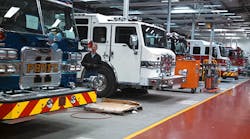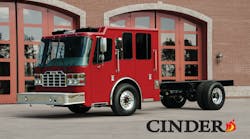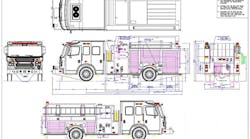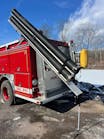I spent some quality time sitting in apparatus cabs recently. I sat in cabs from at least six different manufacturers, not bothered by anybody, completely anonymous.
I was at the New England Association of Fire Chiefs’ Expo in Springfield, Mass., a show over 150 miles from my home, but the closest one that’s large enough to attract major apparatus manufacturers.
As you’ve read in past blogs, my fire department is in the early stages of looking for a new pumper. We’ve only had a couple of meetings, so we're not far into the process, but we’re looking.
Let me explain why I was thrilled to have a few moments of quiet time in the cabs. Usually when I go to large shows, like Firehouse Expo in Baltimore, which is coming up in a few weeks, or Firehouse World in San Diego in February (a great place to be at that time of the year by the way), and others, I know people who want to show me the latest feature they’ve welded on, bolted on, molded on, or in general just improved. That’s fine, it’s my job and don’t we all enjoy seeing and learning about new things?
This was different though, I had my fire department t-shirt on, a pair of blue jeans, no business cards, no notebooks, no cameras, other than my cellphone – just me.
I wanted to look at things like visibility, layout, space, dog house height and general comfort. I climbed into each cab as a customer with a critical eye, exactly what the vendors want to you to do. I even closed the doors behind me to get a feel for spatial design.
It was amazing what I learned.
While I won’t give you a Consumers’ Report kind of recommendation, I can tell you things to look for that might help you pick the kind of cab you want. Spend some quality time in the front and back and see for yourself what each manufacturer offers and determine what you like and what you don’t like. Trust me, after years of going to fire trade shows, one of the only ways to get that kind of hands-on, experiential information is to go to a show. I can think of no other place, except maybe a parade, where you could find such a wide variety of apparatus – and a parade isn’t the best place to ask people to sit in their apparatus, especially for any length of time.
Let me say up front, we’re in the market for a custom cab and chassis, so I didn’t hop into any commercial cabs and chassis – there’s only a handful of those anyway, and, come to think of it, there’s only a couple of handfuls of custom cabs and chassis from different manufacturer. So, my observations are limited to custom cabs.
Approaching the cabs, I was struck by the different treatments manufacturers had for access. Height of the first step is the first notable difference one might consider. Handrails, tread depth, riser height and general accessibility issues should be considered. Keep in mind I was in jeans and t-shirt which makes accessibility easier than being in bunker pants and a coat.
While they were all within a range, a couple were lower than others, and a few where higher. And what a difference four inches can make when climbing up into the cab. Points to grab should be intuitive – when you reach up grab something, the thing you’re supposed to grab on ought to be right there. It’s one thing to be compliant with grab rails and just stick them anywhere, it’s quite another thing to be ergonomically designed to be right where your hand and body wants to be at all times.
There were a few manufacturers that did and some that didn’t and I’m not going to tell you who because it’s subjective and my opinion. I will say, to pay attention to that kind of detail, it will pay off in the long run. I am what you might call a big guy with short legs, so the height of that first step makes a big difference to me.
Just about all the seats were similar in comfort – none were uncomfortable, but some were slightly wider than others and seemed to be positioned better than others. There are only a few seat vendors and they all do a good job. It’s matter of personal preference more than anything else. What can be extremely different is how the seats are mounted and how much the dog house intrude in the space, and the location of door handles and other accessories.
I’ve been behind the wheel of a few fire apparatus in my life, but it’s amazing when you fire up different parts of the brain and start really looking at things with critical eyes. Our current engine, the one that’s going to be replaced, is a 1989 Simon Duplex custom cab. Some of you old timers out there might remember that cab maker. I never really thought about it, but there’s a heater hanging from the roof with blower switches that require the driver to literally almost stand up to turn on. It also impinges on the front view too. And in the officer’s seat, there’s a Mobile Data Terminal (MDT) mounted on the dash that is a real visibility obstruction.
Today’s cabs have heating, ventilation and air conditioning units mounted on top of the apparatus with duct work moving air into the cabs and giving more head room and visibility. MDTs are mounted lower on flat work surfaces and are not as much of a vision blocker as they once had been.
Some manufacturers today have done subtle things like angle the bottom window frames on the front doors. That design is not entirely new, but I’ve never fully appreciated the increased visibility they afford until now.
Some apparatus I jumped into had very narrow bands of front visibility with intrusions from control panels above, high dashboards from below and small windows on the sides. Sitting in them felt borderline claustrophobic.
I also looked at how controls were laid out. Some were like jet fighters with switches and labels and knobs everywhere. Some were clean and simple, intuitive and easy to use. We all know what it’s like to be responding code 3 and trying to get something like warning lights activated and radio responses performed safely.
When considering cab features, take time to really think about, and consider the features different manufacturers offer. For most of us, new apparatus show up once or twice in a career and they’ll be in service for a couple of decades, used by a variety of people along the way. Looking for the best configurations that meet the needs of most will go a long way to meeting your department’s needs.
I spent some time in the back seating area too. That space is just as critical as the front space for the operator, perhaps more. It’s astonishing what a few inches of height, width and depth will do in almost any configuration.
There have been anthropomorphic studies done of firefighters which reveal we take up more space now than we used to, and it’s not just because of all that good firehouse cooking. Firefighters in bunker gear, as it turns out, are much bigger than previously determined.
I know our 1989 engine has four seats lined up side to side, rear-facing with our backs to the dog house. It’s impossible to put on the seatbelt and it’s darn near impossible to get an SCBA on without punching the person next to you in the face. And try to stand up, I dare you.
Angled seats, in all four corners of the rear occupant area help give a little more room and make it easier to don gear. Raised roofs, even a slight raise, provides an extra measure of comfort and safety. Also, while you’re in the back of a rig, check out how each manufacturer builds its steps to get out. Handrails should be placed where they’re needed and steps should have open designs for traction. Even the angle of door opening should be examined. Some manufacturers make doors that swing open to 90 degree angles, front and back, while some have restraints that limit the door swing to prevent body damage. It all depends on who is manufacturing the cab.
Like buying your personal car, spend some quality time inside of it, looking at how things are laid out. Close the door, take a 360-degree look around, in the front and the back – feel it, experience it. And while you’re sitting in there, maybe you might “accidentally” hit the door lock to shut out all the chit chat and make up your own mind.
After all, you’ll be the one living with your decision for years to come.
